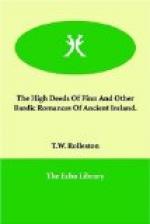The Story of Etain and Midir. This beautiful and very ancient romance is extant in two distinct versions, both of which are translated by Mr A.H. Leahy in his HEROIC ROMANCES. The tale is found in several MSS., among others, in the twelfth century BOOK OF THE DUN COW (LEABHAR NA H-UIDHRE). It has been recently made the subject of a dramatic poem by “Fiona Macleod.”
How Ethne quitted Fairyland is taken from D’Arbois de Jubainville’s CYCLE MYTHOLOGIQUE IRLANDAIS, ch. xii. 4. The original is to be found in the fifteenth century MS., entitled THE BOOK OF FERMOY.
The Boyhood of Finn is based chiefly on the MACGNIOMHARTHA FHINN, published in 1856, with a translation, in the TRANSACTIONS OF THE OSSIANIC SOCIETY, vol. iv. I am also indebted, particularly for the translation of the difficult Song of Finn in Praise of May, to Dr Kuno Meyer’s translation published in Eriu (the Journal of the School of Irish Learning), vol. i. pt. 2.
The Coming of Finn, Finns Chief Men, the Tale of Vivionn and The Chase of the Gilla Dacar, are all handfuls from that rich mine of Gaelic literature, Mr Standish Hayes O’Grady’s SILVA GADELICA. In the Gilla Dacar I have modified the second half of the story rather freely. It appears to have been originally an example of a well-known class of folk-tales dealing with the subject of the Rescue of Fairyland. The same motive occurs in the famous tale called The Sickbed of Cuchulain. The idea is that some fairy potentate, whose realm is invaded and oppressed, entices a mortal champion to come to his aid and rewards him with magical gifts. But the eighteenth century narrator whose MS. was edited by Mr S.H. O’Grady, apparently had not the clue to the real meaning of his material, and after going on brilliantly up to the point where Dermot plunges into the magic well, he becomes incoherent, and the rest of the tale is merely a string of episodes having no particular connexion with each other or with the central theme. The latter I have here endeavoured to restore to view. The Gilla Dacar is given from another Gaelic version by Dr P.W. Joyce in his invaluable book, OLD CELTIC ROMANCES.
The Birth of Oisin I have found in Patrick Kennedy’s LEGENDARY FICTIONS OF THE IRISH CELTS. I do not know the Gaelic original.
Oisin in the Land of Youth is based, as regards the outlines of this remarkable story, on the LAOI OISIN AR TIR NA N-OG, written by Michael Comyn about 1750, and edited with a translation by Thomas Flannery in 1896 (Gill & Son, Dublin). Comyn’s poem was almost certainly based on earlier traditional sources, either oral or written or both, but these have not hitherto been discovered.
The History of King Cormac. The story of the birth of Cormac and his coming into his kingdom is to be found in SILVA GADELICA, where it is edited from THE BOOK OF BALLYMOTE, an MS. dating from about the year 1400.




